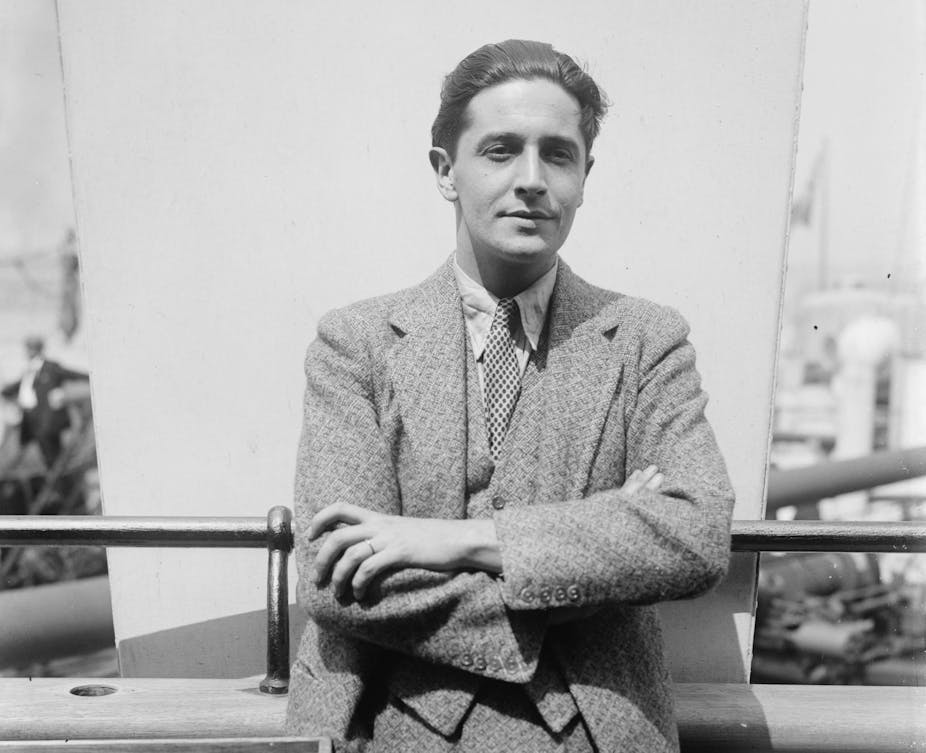One of the most famous anthems of the First World War is 100 years old. Keep the Home Fires Burning was originally published on October 8 1914 under its original title, Till the Boys Come Home. Few songs have rivalled its cultural impact. And the song was reputedly the result of a competition to write a war song between the composer, Ivor Novello, and his mother in 1914.
The song made Novello’s name. It allowed him to become, as actor-manager-composer, the leading light of British musical theatre at that time. In the 1920s he also arguably became the first major star of British cinema who could compete with Hollywood idols in the age of Rudolph Valentino.
Novello was raised in Cardiff in an atmosphere of music. His mother, Clara Novello Davies, was the celebrated leader of the Welsh Ladies Choir, and Novello (briefly) attended Oxford’s Magdalen College School on a soprano scholarship. He was 21 when he competed with his mother to compose a war song, and Home Fires was the result. Novello wrote the title line of the song and its main melody, before the American poet Lena Gilbert Ford (who would die in an air raid two years later) completed the lyrics.
The song gained the hearts of the public from its first public performance. By February 1916 over a million copies of the sheet music had been sold, and the song had been translated into at least six languages, earning the composer a sum that today would make him a millionaire. Novello’s personal charisma helped publicity, as it would at every stage of his career.
The adjective wartime commentators most often used to describe the song was “haunting”; evoking its wistful, ubiquitous presence and the compelling effect of its melody. The song bridged the physical and emotional distance between the trenches and the home front with a beautifully circular image: the “boys” at the front yearn for those at home, and vice-versa. Invoking familiar phrases and coining new ones, it struck just the right note for the early stages of the war with its simple and appealing message of hope. Yet its melancholy undercurrent, rendered with great craft, was just realistic enough to acknowledge the genuine suffering of the war as it carried on.
Novello himself had clear ideas about how the song should be performed. Writing in the magazine Home Notes before Christmas in 1915, the composer guided the reader through the song’s remarkable shifts in tone, from the initial “bold attack”, the “growing crescendo” as the lyrics tell us that “the country found them ready”, that falls to a “sustained, soothing sound” on the word “yearning”, before stressing the cheerfulness of the imperative to “turn the dark cloud inside out”. He also warned: “Whatever happens, don’t overdo it.” For a man whose image today is often, wrongly, associated with purely escapist nostalgia, Novello precisely understood the needs of his audience, and adjusted his performance accordingly.
In the summer of 1915, the song’s impact became particularly visible. One New York Tribune contributor reported in August 1915 that music was to be heard everywhere in London, and that:
The last sound that caught my ears as the boat-train pulled out of London was not the subsiding of women who bade goodbyes, but a soldier-voice, high-pitched, a little off key, valiantly singing: ‘There’s a silver lining’.

Newspapers, including the Daily Mail, Evening News and Daily Sketch responded by reproducing the music and lyrics for their readers, often across the whole front page.
Novello’s music publisher subsequently advertised the availability of permissions to use the song in pantomimes at the end of the year, promoting it as “the ideal chorus number”. And indeed it was. At pantomimes at Drury Lane, the Aldwych (the theatre below Novello’s London flat), or around the regions, the song was met with cheers and applause, often by audiences entirely composed of soldiers on leave. The Daily Telegraph described one Christmas Eve performance where the singing audience of soldiers, with the wounded brought in on stretchers, as “a strange blend of the pathetic and the gladdening”, much like the song itself. Novello would perform the song hundreds of times for troops in France in 1916 and the association would endure through his public persona.
In 1925, Novello told Picture Show readers that the cultural impact of Home Fires was: “the best thing that has happened in my life … It had to do with big issues, and I am proud that I had this connection with them”. His legions of film fans were well aware of Novello’s close association with the war and it adds another dimension to the handsome, but often troubled, men he played on screen, not least his best known, and highly suspicious, appearance in the title role of Alfred Hitchcock’s The Lodger in 1926. Novello was a major star who could play in a minor key.
In the 1920s, Keep the Home Fires Burning was already functioning as a shortcut to memories of the Great War, whether direct or vicarious, in films and literature. In Sinclair Hill’s remarkable The Guns of Loos (1928), a story of tensions amid the 1915 munitions strikes, the singing of Novello’s song momentarily reconciles its characters, while in 2001, Robert Altman’s Gosford Park, used it, and Novello’s presence, to similar effect.
Now, 100 years on, the continuing resonance of Keep the Home Fires Burning reminds us of Ivor Novello’s powerful place in British cultural history.

